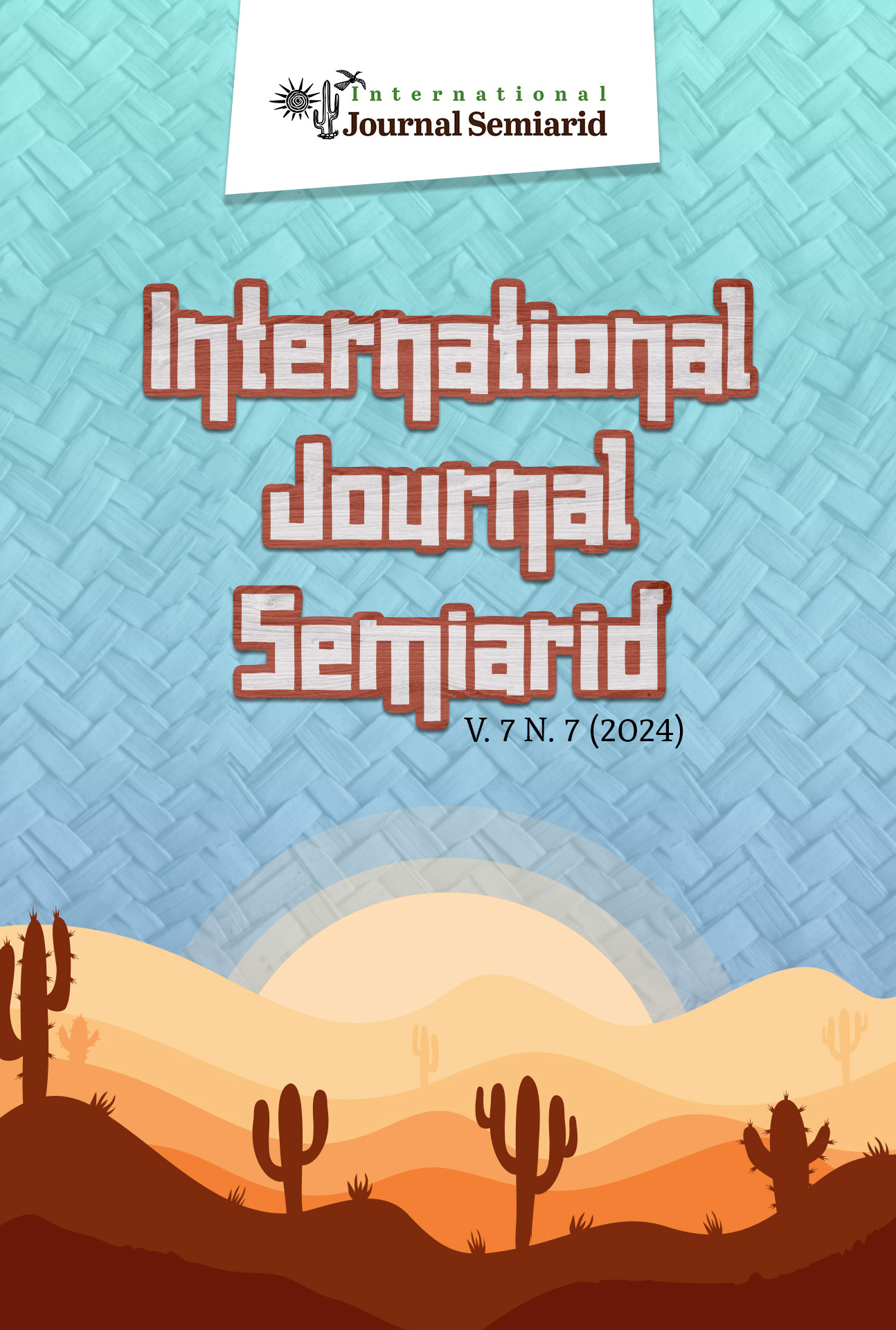IRRIGATION WITH SALINE WATER AND USE OF ORGANIC MATTER CHANGE Gliricidia sepium SEEDS QUALITY
DOI:
https://doi.org/10.56346/ijsa.v7i7.199Keywords:
germination, forage crop, ; Semi-aridAbstract
The aim of this study was to evaluate effects of irrigation with saline water on the germination of Gliricidia sepium seeds linked to the effect of organic matter supplementation to mitigate recurrent effects of high salt content in water. The experiment was conducted under a completely randomized statistical design in a 5 x 2 factorial treatment design, with five different irrigation water electric conductivities ECw (0.5, 1.0, 2.0, 3.0 and 4.0 dS m-1) and two organic matter supplementations (no-organic matter and organic matter supplementation), using five replicates. The experiment was carried out under tape knitted shade cloth, shading rate of 50%. Variables of average germination time (days), relative germination frequency (%) and informational entropy (bits) were analyzed. The increase in the irrigation water salinity caused a longer time needed for the Gliricidia sepium seeds to germinate, however, the use of organic matter performed as a mitigating factor for the effects caused by the high salt content in the irrigation water when a high frequency of germination was observed in shorter times.
References
REFERÊNCIAS
ALLEN, R. G.; PEREIRA, L. S.; RAES, D.; SMITH, M. Crop Evapotranspiration: guidelines for Computing Crop Water Requirements, vol. 56. Rome: FAO, 1998. 15p.
FARIAS, S. G. G. Estresse osmótico na germinação, crescimento e nutrição mineral de glicirídia (Gliricidia sepium (Jacq.). 61f. (Dissertação – Mestrado) UFCG. Brasil, 2008.
FERREIRA, D. F. Análises estatísticas por meio do Sisvar para Windows versão 4.0. In. Reunião anual da região brasileira da sociedade internacional de biometria, 45, 2000. São Carlos, SP: SIB, p. 255-258, 2000.
FLUCK, A.C., SCHAFHÄUSER JÚNIOR, J., ALFAYA JÚNIOR, H., COSTA, O.A.D., FARIAS, G. D., SCHEIBLER, R. B., RIZZO, F. A., MANFRON, J. A. S., FIOREZE, V. I., RÖSLER, D. C. (2018). Composição química da forragem e do ensilado de azevém anual em função de diferentes tempos de secagem e estádios fenológicos. Arquivo Brasileiro de Medicina Veterinária e Zootecnia, 70(6), p.1979-1987.
JELLER, H; PEREZ, S. C. J. G. Efeitos dos estresses hídrico e salino e da ação de giberelina em sementes de Senna spectabilis. Ciência Florestal, v. 11, p. 93-104, 2001.
JÚNIOR, J. M.; TAVARES, R. D. C.; MENDES FILHO, P. F.; GOMES, V. F. Efeitos de níveis de salinidade sobre a atividade microbiana de um Argissolo Amarelo incubado com diferentes adubos orgânicos. Revista Brasileira de Ciências Agrárias, Recife, v. 4, n. 4, p. 378-382, 2009.
LABOURIAU, L.G., VALADARES, M.E.B. On the germination of seeds Calo-tropisprocera (AIT.) AIT.f. An. Acad. Bras. Cienc. 48, 263–284, 1976.
MARCOS FILHO, J. Fisiologia de sementes de plantas cultivadas. Piracicaba: Fealq, 2005. 465 p.
MAYER, A.M.; POLJAKOFF-MAYBER, A. The germination of seeds. 4.ed. Great Britain: Pergamon Press, 270p, 1989.
MEDEIROS, J. F. de; SILVA, M. C. C.; SARMENTO, D. H. A.; BARROS, A. D. de. Crescimento do meloeiro cultivado sob diferentes níveis de salinidade, com e sem cobertura do solo. Revista Brasileira de Engenharia Agrícola e Ambiental, v.11, p.248-255, 2007.
NASSIF, S. M. L.; PEREZ, S. C. J. G. Efeito da temperatura na germinação de sementes de amendoim-do-campo (Pterogyne nitens Tul.). Revista Brasileira de Sementes, v.22, n.1, p.1-6, 2000. DOI: 10.17801/0101-3122/rbs.v22n1p1-6.
PACHECO, A. G.; ALMEIDA, C. A. C.; DIAS, M. S., REIS, L. S.; ELIAS, J. J.; PINTO, A. D. V. F.; SILVA, T. S. S. Germinação e crescimento inicial de girassol (Helianthus annuus L.) sob diferentes substratos submetidos a estresse salino. Brazilian Journal of Development, 6(9), 71281-71296, 2020.
PRIMO, D. C.; MENEZES, R. C.; SILVA, T. O. Substâncias húmicas da matéria orgânica do solo: uma revisão de técnicas analíticas e estudos no nordeste brasileiro. Scientia Plena, [S. l.], v. 7, n. 5, 2011.
RAMAMOORTHY, M.; PALIWAL, K. Allelopathic compounds of Gliricidia sepium (Jacq) Kunth ex Walp. And its effect on Sorghum vulgare L. J. Chem. Ecol., v. 19, n. 8, p. 1691-1701, 1993.
REBOUÇAS, M.A.; FAÇANHA, J.G.V.; FERREIRA, L.G.R.; PRISCO, J.T. Crescimento e conteúdo de N, P, K e Na em três cultivares de algodão sob condições de estresse salino. Revista Brasileira de Fisiologia Vegetal, v.1, n.1, p.79-85, 1989.
SÁ, F. P.; SÁ, C. O.; SÁ, J. L.; AMORIM, J. A. E.; MENEZES, T. S. A.; LÉDO, A. S. (2014). Desenvolvimento inicial in vitro de gliricídia em diferentes níveis de salinidade. Scientia Plena, v. 10, n. 4 (a), 2014.
SÁ, M. K. N., DE ANDRADE, A. P., MAGALHÃES, A. L. R., DE LIMA VALENÇA, R., CAMPOS, F. S., DOS SANTOS ARAÚJO, F., & DE ARAÚJO, G. G. L. (2021). Silagem de palma forrageira com Gliricidia Sepium: alternativa alimentar para o Semiárido. Research, Society and Development, 10(2), e27210212473-e27210212473.
SANTANA, D.G., RANAL, M.A. Análise da germinação: um enfoque estatístico. 1 ed. Universidade de Brasília, Brasília, 2004. 247 p.
SANTOS, J. Processos hidrológicos e sedimentológicos em clima semiárido tropical. 2015. 168 f. Tese (Doutorado em Engenharia Agrícola) - Centro de Ciências Agrárias, Universidade Federal do Ceará, Fortaleza, 2015.
SOUZA, L.F., GASPARETTO, B. F., LOPES, R. R., & BARROS, I. B. Temperature Temperature requirements for seed germination of Pereskia aculeata and Pereskia grandifolia. Journal of Thermal Biology, v. 57, p. 6-10, 2016.


